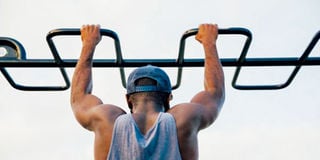Why you should be doing more pull-ups

No matter which variation you choose, pull-ups will dramatically improve your upper body strength and will most probably make other exercises seem even easier to do.
What you need to know:
Pull-ups are an excellent tool for strengthening and elongating muscles. If you do pullups regularly, you may find that your posture begins to improve.
A pull-up is an upper-body strength exercise that is daunting to many but very beneficial for cross-fitters, bodybuilders, and anyone interested in general body fitness. Elly Muhereza, a fitness coach, says pull-ups are one of the most effective upper body exercises useful for developing strength and muscle mass in the back and biceps. “They are versatile, working on muscles in the arms, shoulders, chest, and abs in one movement. Doing pull-ups regularly will help one build posture,” he says.
Hard to do
However, Bobby Mutumba had had a rough time during school football training days. “Pull-ups was one of the drills and I just never made it past five. While I loved football, the shame that I always failed made me lose the zeal. If the boys never laughed at me, maybe I would have made an effort to get better and not quit school football. But I could not take the ridicule, I just let go,” he shares.
Muhereza says: “Pull-ups are not easy to learn, for many reasons. To begin, most people struggle with shoulder mobility. Then there is the fact that you are lifting a large percentage of your bodyweight which is not easy. It is after one has mastered this that they will succeed.”
Technique
Pull-ups are more than hanging from a bar and pulling up until your chin is above the bar. They also call for understanding the different distinctions in pull-ups in order to keep your shoulders healthy as you build your back muscles. There are three phases to pull-ups:
At the bottom: While it is easy to just hung, Muhereza says you should never allow for tension to leave your back. “Straighten your arms fully while maintaining tension in your shoulder girdles (muscles around your shoulder blades and collarbone),” he says.
Muhereza adds that doing what is commonly referred to as the ‘dead-hung’ position where one lets their shoulder blades shrug to your ears is not good as it places strain on your rotator cuffs and bicep tendons.
Halfway: As you start pulling up, pull your shoulder blades down and back as your elbows move towards your ribs rather than using your arms alone. In so doing, you are controlling your shoulder blades and shoulders using ‘scapulo-humeral rhythm’. Muhereza attests that doing it this way is crucial for the health of your shoulders and only then will you reap greatly from the workout.
At the top: With your chin above the bar, keep pulling. Before you get back to the bottom, squeeze your shoulder blades and try to hold on for a while. “Let it be as though you are still going upwards inasmuch as you have reached the peak. And as you do so, do your best to maintain tension in your glutes and abs,” Muhereza says.
He adds that in this position, your torso might slightly lean backward, causing your hips and feet to go in front of the bar but do not allow your shoulders to project to the bar, which can cause a rotator cuff injury. Mutumba chose to perfect his pull-up workout at home, seeing that one can do it from anywhere. “Difficult as it were, mastering them has helped position my body to get more out of other exercises such as bench presses,” he says.
Benefits
In our daily life, we do lots of activities such as standing, sitting. However, with pull-ups, which is a dynamic compound workout, the relationship between your nervous and muscular systems is strengthened. “That has helped me do simple activities as well as the difficult ones with more ease than before,” Mutumba attests.
Improved posture
As one does pull-ups, their back and core muscles are strengthened. “With all these muscles attached to the back, one attains a better posture. That also causes you to look leaner and longer, something everyone desires,” Muhereza says.
Alleviating back pain
Lately, there are more people sitting for longer hours than they engage in rigorous activity. With all this sitting, physiological load on one’s back increases. To deal with this, Muhereza advocates for pull-ups as they help you avoid back pain and injury in future.
He adds that pull-ups help define your biceps and back while also working on your core. These help to make your waist look small and give you a toned body making your physique look impressive.
Caution
However like any other exercise, Elly Muhereza, a fitness coach, says overdoing pull-ups alone or doing them the wrong way might put your posture at a risk (having a deformed posture) such as having a very huge upper body with very small legs. “So, as you do your workouts, it is important to balance between the upper, core, and the lower body,” he says.




